Tallbacka in 2023
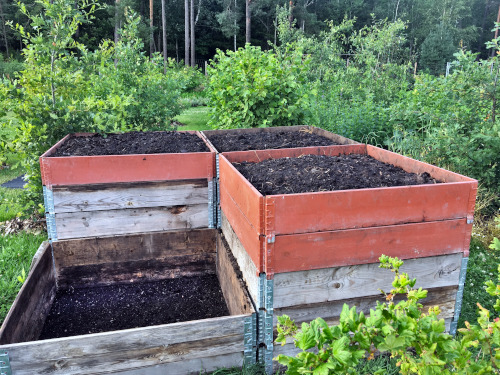
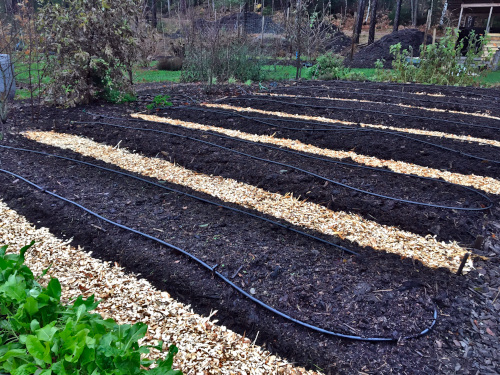
The year 2023 has been marked by worries and fears. The pandemic retreated but remained in the background and war filled the news. For our part, we have tried to stay on the side of the good and continue a meaningful life. That meaning is to be found in the garden.
In the garden we are still not protected from money worries, diseases and fatigue. We decided to focus on NO-DIG cultivation in the garden and it takes time to learn something new and consolidate the new method. We have also decided to make everything public and have opened the garden for visitors even though it is not finished and we do not know everything. We take a conscious risk that you need to do with something new that deviates from the usual. Sometimes it hurts, but usually love of everything that grows was the greatest of our emotions. We have decided to continue.
NO DIG composting
2023 was the second year we applied NO DIG composting. By then, we had already gained experience of different composting methods, the required materials, the amount of work and, above all, how much compost is needed. Tallbacka’s compost manager Outi took the matter very seriously and decided to use the bulk of her energies producing compost so as to have enough compost for the growing beds. We had also had some unfortunate experiences. For example, the soil factory with bokashi compost that we had started with great expectations was a bitter disappointment. The bokashi process was unsuccessful and our own idea of putting bokashi compost and soil in different layers did not work. The end result was a compost mixture with a rock-hard surface and dense weed growth. Our ordinary composts were too wet and froze in the winter, resulting in the whole process taking too long. The Berkeley Hot Compost method, on the other hand, was promising. Wood chippings, garden waste, horse manure, leaves and coffee grounds were available. How much compost is it possible to produce in a season? We decided to try and find out. The winter proper did not come until March, so there was snow well into April. On April 10th, the first two composts made of pallet collars (1.2 x 1.2 x 1m) high) were full. The Berkeley compost should be turned from the fifth day every other day until the material has changed to even, but still coarse, compost soil. The worms also work hard after the initial heat of the process subsides. The most difficult part of the process is to keep the moisture at a suitable level; during the summer the composts wanted to dry even though we covered them with a tarpaulin to minimize evaporation.
After the first two, we made several more. In the end there were a total of about 20 of which some were joined during the final process. In June we also started collecting regular garden composts the solid composts we built using Dowding’s model. We can state that after working all summer we got a substantial stock of good quality compost spread on almost all the growing beds in the autumn. It was satisfying to have the compost spread out as cover material before winter. The compost has time to settle, worms and other microbes can begin their decomposing work and in spring when the snow has melted the soil is ready for planting. The compost is not manure and it does not dissolve in rain or snow. The soil improves as the micro-organisms multiply.
For many reasons, the compost cover is second to none for soil health. Drought seems to be a recurring problem for spring and early summer. A soil that is covered with compost tolerates drought much better, the soil micro-life and fungal hyphae form a structure that effectively binds water. We are convinced that the wood chippings between the growing beds is an excellent way to reduce evaporation and increase the number of fungal hyphae. It is possible to walk on the NO DIG beds, the ground becomes resilient and is not compacted. The rainwater is absorbed into the soil more efficiently, partly because of the worms. There is no need for fertilizers and no need to worry about pH values or lack of trace elements. A living soil balances itself and the microorganisms have their own ways of releasing molecules for plants to use. We humans don’t understand all these subtleties, but fortunately we don’t have to either! It is enough for us to provide food and favourable living conditions, then they will do the work for us.
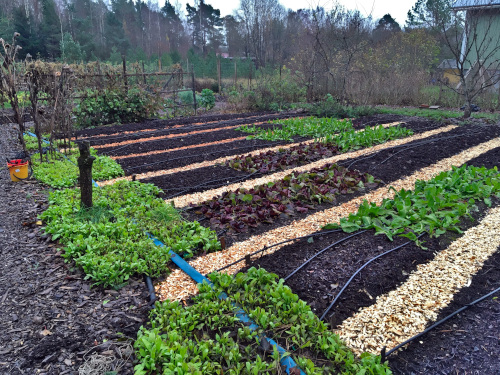
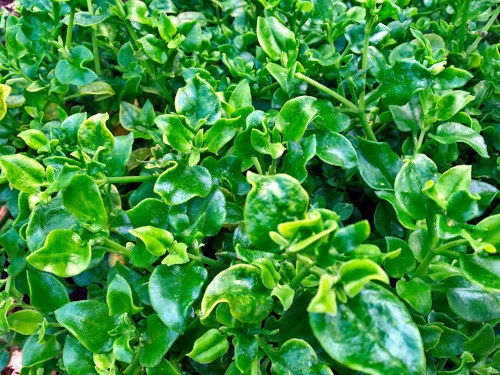
Salad Mix-promising introduction and an easy adjustment
The salad mix that we developed in 2022 is an excellent product. It varies according to the season, consists of many tasty salad plants, is fabulously beautiful and full of surprises! It was clear, however, that the development work needed to be continued. Some of the varieties did not yield enough, other varieties tested were not durable enough or were plagued by pests and some tasted too strange. But lettuce, leaf lettuce, spinach, garland chrysanthemum and buck’s-horn plantain worked nicely and the variety of lettuce varieties made the mix wonderfully beautiful and colorful.
In the spring we got the strangest growing experiences and surprises when we tried to investigate germination problems in salads. The final cause was never clarified, but the salad seeds germinated poorly. We dismissed the obvious causes: temperature too high, high humidity or drought. We tried different soil mixtures, shop-bought and our own. Maybe the seeds were bad or the moon phase was wrong or something else. The planned selection of varieties and their early introduction went awry and we were could only grow what germinated. After that experience, we can’t boast of our skill at pushing up seedlings. Every healthy plant is a wonder and a joy.
We got a new variety for the salad mix. A fascinating novelty, although only tasting a small bit, were the sour leaves of mountain sorrel. Garden sorrel gives a big and tasty harvest but does not fit into the salad mix as the snails eat holes in it, the shield-leaf sorrel again is beautiful and tasty but hopelessly slow to harvest. Mountain sorrel is very tasty and easier to use. Last year’s small test area will be expanded.
The salad mix needs flavours and character from salad mustards and rocket so this coming summer we will grow them in the greenhouse. Outdoors, unfortunately, it does not do well – flea beetles eat the leaves completely or fill them with holes. The drought of early summer favours flea beetles and covering with fleece doesn’t help.
The salad growing technique we learned from Charles Dowding is excellent and have admired it many times. The plants are grown individually and they are planted at a distance of about 20 cm from each other. The harvest is collected from the older outer leaves, which allows the plant to produce a new fresh harvest for one and a half months. Finally the plant begins to go to flower and the leaves become woody and bitter. A continuous plant production is important so you can get a new harvest without breaks. Last summer we discovered that it is important to harvest all the time. Only in this way can quality be maintained. It may be wise to harvest even if there is no buyer for the product – the older leaves use the plant’s energy resources unnecessarily and also attract snails. (This is, of course, a frustrating way to make compost!) In the coming season we will work to have a more even harvest time so that the plants can produce a harvest for as long as possible.
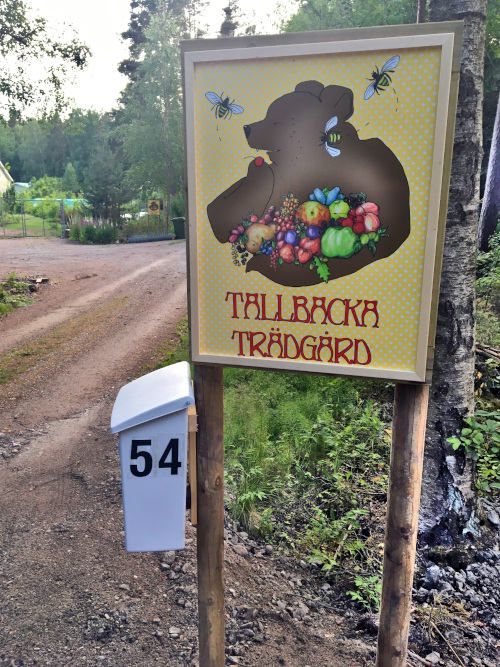
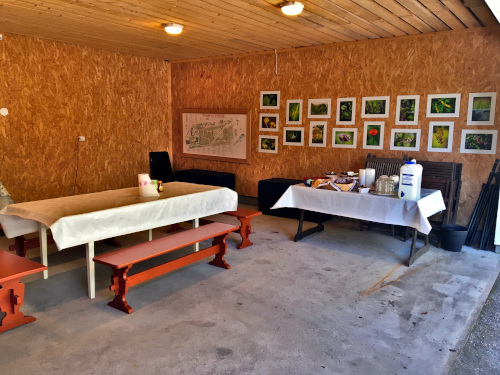
The visitor garden
Openness is one of Tallbacka’s main ideas. We welcome guests throughout the season.
Gradually, we have created an infrastructure and a functional system to be able to welcome a bus full of guests and introduce them to our NO DIG garden. You need information boards, a good road and a wide road junction (renewed in the spring of 2023), with a turning point for the bus, a sufficient number of seats for an initial presentation and a roof in case of rain, a nice eco-loo and the possibility to wash your hands, a fully planned guide route, some snacks to offer and also something to sell. Of course, this increases the workload when there is already enough, but things are gradually becoming routine. And it is definitely worth the trouble! Although it is always exciting when guests arrive and we get tired out, the fatigue is quickly forgotten. It is a pleasure to talk about the garden to people who are interested to listen about, and curious to see, what we grow. Soil improvement is also fascinating for others and almost addictive. It’s great to meet people who share the love of everything that grows.
We have continued to develop the visitor garden in 2023 and have plans for the current year. We want the richness of species to be great; on the website we have a cultivation list, which includes more than 500 species and varieties. We are always very interested in new plants and presenting the forgotten traditional plants that are worth keeping in cultivation. We try to create small units, thematic islands, plant groups with a story. Part of this work consists of taking care of the edging of the borders and weed removal, but also the great ideas that arise when you see what “should” grow in a place and how the edge of the growing bed “should” curve! Some plants finds their place and thrive excellently, next to another plant – and so the story goes on. We have named almost all such places with their own names, which is an important part of Tallbacka’s story.
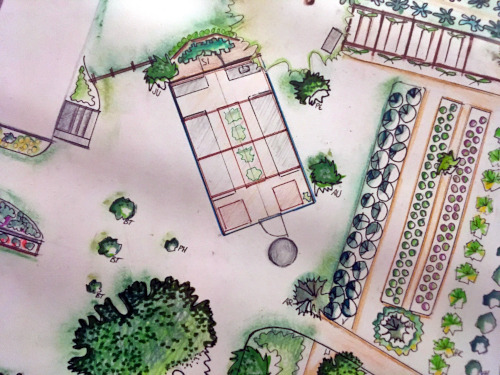
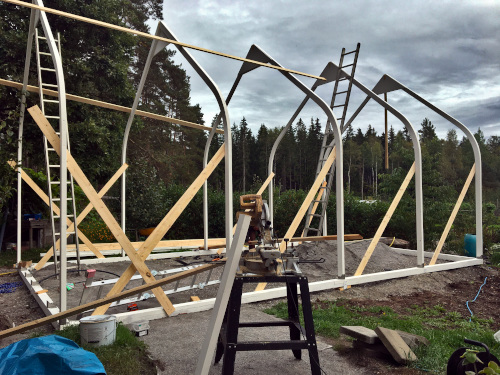
PLANTGREENHOUSE
Ever since 2018, we have had a dream of a greenhouse with the ability to have delicate fruit trees in the garden such as apricot, peach and fig.
The blueprints for a winter greenhouse were approved in 2020, so the last opportunity for us was to start in the autumn of 2023. However, the estimated cost showed that it was not possible to build a winter greenhouse, so we slimmed down the plans to a plastic greenhouse. But we needed to begin in the spring of 2023 by removing the growing boxes that were from 2016. It turned out that the pallet collars closest to the ground had partially rotted, so they would have been replaced anyway. We took the soil and put it in a pile while we waited for construction to start.
In August we started to excavate the construction site and the area which was about 9 x 11 m. According to the plans the building itself was 4.60x 8 m with a ceiling height of 4.30. The surface was levelled with a gravel covering water pipes, electric cables and sewage pipes. The water and electricity connection was taken from the basement of the house. The foundation was laid with the ground anchors drilled into the ground. A wooden frame was fastened on them to which the roof trusses including wall beams were screwed. The inner ceiling beams were screwed to the ceiling trusses and both gables were given standing struts. (see picture and drawing).
The greenhouse plastic was applied towards the end of October. On October 20th the plastic was fixed with the help of aluminium strips on roof trusses and gable beams. The openings on the ventilation hatches in the roof were fixed and so we had to stop the work due to winter and cold weather. The hatches were delivered in November but are now waiting for better weather conditions.
In December the electricity was run to the greenhouse, but we did not have time to install the lighting. The boards for the protection of the handling of the plant and plugboards were screwed in as well as the boards for the sinks.
The doors on each side, as well as the ventilation hatches, will have to wait to be installed next year.
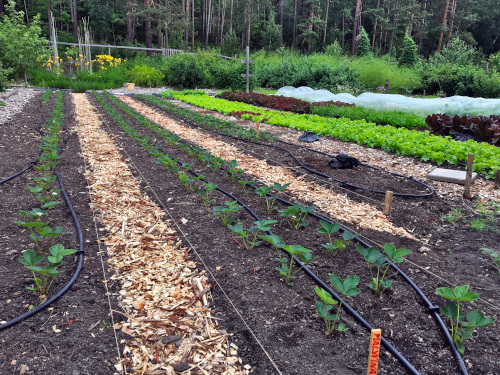
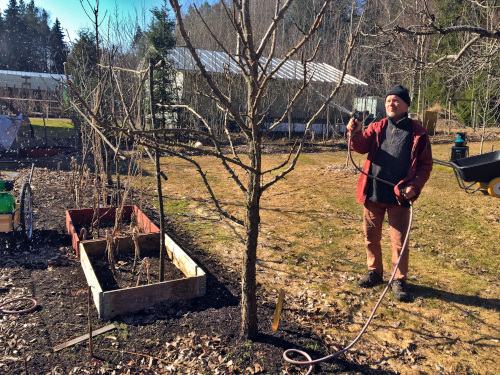
New vitality for berries and fruits
It has been 6 years since most of our berry bushes and fruit trees were planted. The exceptionally severe drought in 2018 and 2019 caused problems and in some cases certainly caused many of the difficulties we have encountered. They made us look for a solution to the problems and eventually change the cultivation method. The soil does not recover immediately and the plants may never fully recover, but what’s done is done; We also didn’t want to dig everything up and start all over again. The mistakes annoyed us, but that won’t help us to move on. I have previously written about mulching and the gooseberry sawfly. Cherry trees and sweet rowans died during the icy winter of 2021-2022. The raspberries no longer yielded a proper harvest so we decided to remove them. The currant bushes are plagued with the currant moth, which took a large part of the harvest and made the harvest labour intensive. We have harvested berries for our own use and filled our freezers, but only a fraction of the potential harvest, and the quality has not always been the best. Something must be done about the situation!
Michael Phillips ”The Holistic Orchard”
When we were looking for methods to help the berry bushes and fruit trees that were already planted, we found the huge book of the American Michael Phillips about holistic orchard cultivation. The book is unique in terms of the amount of text but also in terms of its content. Phillips strives for naturalness and health in all areas; the health of the soil, the health of the grower and the functioning of the ecosystem as a whole. In addition to being large and beautiful, Phillips’ orchard apples are also superior in nutritional content. All measures, which he deals with in his garden, are aimed at the well-being of fruit trees, which means pests and diseases do not cause great damage. I must immediately clarify that the appearance of his garden does not correspond to the established ideals and the surroundings do not look like a golf course!
From the book we immediately applied some practical methods. When we remove the bush wood, we get wood chips, which are beneficial for fruit trees and berry bushes. As it decays, the soil in the garden is favoured by fungi and microorganisms. We compost the wood chips and also use them as covering material for the paths between the beds. We don’t cut the dandelion flowers because the pollinators need them. Around the fruit trees we plant comfrey, which is an excellent accelerator plant with its deep tap roots that produce a large mass of leaves during the season and release large amounts of minerals, as they decay, to the fruit trees. Comfrey has time to produce several leaf harvests and flowers during a season. We started to make a mixture of neem oil, EM microbes and algae powder and spray the solution onto the vegetation. Phillips also adds fish oil to the mixture, but we have not been able to find such oil in Finland. In 2023, we carried out the treatment twice, at the budding at the beginning of the season and at the beginning of flowering. Phillips does the treatment four times and closely follows the development of the tree. He is constantly aware of when the pests appear and develop and can limit the actions to the right time. He particularly emphasises the importance of thinning the apples before they ripen. We have a lot to learn! The main concerns are sawfly damage on berry bushes and fungal infestation on plums. We intend to continue and learn more and hopefully we will eventually get a better balance in the orchard. Our resources and time still do not allow for such accuracy as Phillips’ book instructs, but we do what we can.
New round of strawberries and raspberries
For the time being, we have no reason to be satisfied with our strawberry cultivation. The first attempt suffered from the drought and the associated manganese shortage and the well-cultivated soil caused problems with planting. The plants of the second experiment had probably been so badly damaged during transport that they never had the strength to grow properly. The winter killed most of the plants so we lost two seasons without a proper harvest, which was frustrating. When it came to the third attempt, we focused on the seedlings. They are micropropagated in Pargas and raised at Peuraniemi nursery, the varieties are Malwina and Lumotar. The first summer is over and the soil is getting better so we hope for the best.
In 2018, we made 35 meter long hügelbeds on both sides of the newer part of the garden. We grew pumpkins in them the first year and later cabbage, onions and carrots. The southern bed turned out to be too dry for vegetables and as we had removed the old rows of raspberries at the same time, we decided to plant new raspberries in the long bench. We thought of different varieties but chose the Glen Ample variety and some cherry bushes (Porthos, Athos) from Savonlinnan taimisto. In April 2023 we planted 60 raspberry plants and later in the summer we built supports as sturdy as was economically possible. During the autumn we spread old leaves and horse compost over the bed. Berry and fruit growing has been challenging and not easy for us. We didn’t put in as much effort as was required. Our knowledge and experience has not been enough. But we learn all the time. We hope that the measures we have taken will eventually lead to a good end result. So that the Tallbacka Bear on our logo gets its arms full!